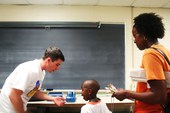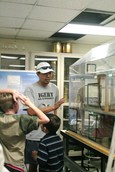Highlight
IGERT Trainees Educate the Public and Inspire Young Scientists
Achievement/Results
For the third straght year, trainees and affiliates of the National Science Foundation’s (NSF) Integrative Graduate Education and Research Traineeship (IGERT) program in Indoor Environmental Science and Engineering at The University of Texas (UT) have been actively involved in a wide range of public outreach efforts. These activities provide a service to the community, but also allow our students to hone their public communication skills and to work as interdisciplinary teams on public outreach activities. In total, our IGERT students have been involved with over 250 hours of community service over the past year.
IGERT faculty participant Richard Corsi delivered a 90 minute presentation entitled “Is Your House Killing You?” as part of the UT Environmental Science Institute’s Hot Science – Cool Talks outreach lecture series. The presentation was open to the public and attended by over 500 people. For 90 minutes prior to the presentation, eight IGERT trainees and affiliates presented demonstrations to attendees and answered questions related to indoor air quality. Trainee Matt Earnest brought numerous cleaning products to the event and educated the public on the toxic chemicals in those products, proper product usage, and combinations of products to avoid. Trainee Elliott Gall and affiliate Donna Kunkel completed demonstrations using an ion generator (which emits ozone) and various scented sources that emit terpenes (from essential oils) to demonstrate rapid ozone chemistry and the organic particles that form from such chemistry. Trainees Diana Hun and Brent Stephens used a popular House of Pressure, a scaled-down see-through model of a home that uses chemical smoke as a tracer, to demonstrate how air movement and pollutant transport in homes is affected by fireplaces, exhaust fans, and more. Affiliate Chi Hoang discussed the relative amounts of pollution emitted from different types of candles (olefin vs. soy vs. beeswax, etc.). Affiliate Donghyun Rim used a breathing thermal manikin to illustrate the concept of thermal plumes caused by the warmth of the human body, and the impact of thermal plumes on pollutant transport around the body. Trainee Sonny Rosenthal discussed the making of a seven minute video entitled “Dick Radonsky” about a clumsy detective who investigates an indoor air-related illness of a young woman in her home. He also discussed a 30 second public service announcement about cooking and indoor air quality, and featuring a smoking fish. The videos were developed by IGERT trainees and affiliates as part of an IGERT Technical Exchange course. The videos were then played for the audience prior to Dr. Corsi’s presentation, and were met with great laughter and applause. The videos can be found at http://www.indoorquality.org/PSAs/index.cfm.
Several IGERT trainees and affiliates repeated the demonstrations described above over a six hour period during UT Explore, a large and annual public open house on the University of Texas campus. Between 100 and 200 members of the public participated in the demonstrations.
In collaboration with lectures delivered by IGERT faculty participant Richard Corsi, several trainees repeated the demonstrations as part of the Minority Introduction to Engineering (MITE) summer Science camp involving 100 minority high school students who are considering attendance of college in an engineering discipline. Similarly, IGERT faculty participant Jeffrey Siegel worked with several IGERT trainees to provide lectures and demonstrations to young high school women as part of the UT Women in Engineering Program.
Seven IGERT trainees and affiliates spent over six hours judging over 100 science projects at a local elementary school. This is the second straight year that IGERT students served as the majority of judges at the science fair.
Address Goals
The aforementioned outreach activities go to the heart of learning, not just for the public that receives information from our IGERT students, but also for our IGERT students. Students need to “boil down” complex subjects in such a way that the general public can understand those concepts. In doing so, our IGERT students employ state-of-the-art demonstrations of pollutant emissions, air flow in buildings, and the effects of human beings on indoor air flow.








